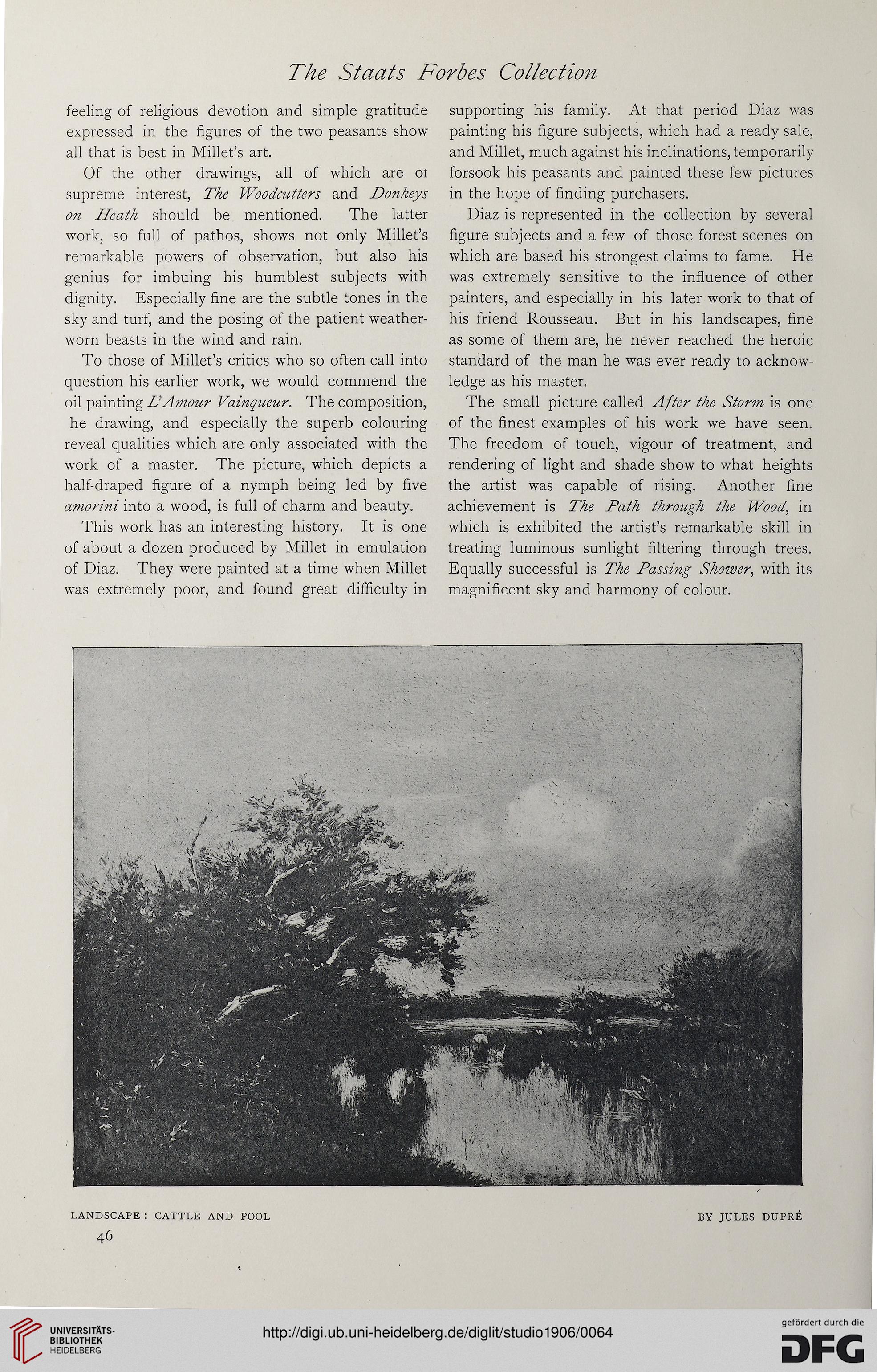The Staats Forbes Collection
feeling of religious devotion and simple gratitude
expressed in the figures of the two peasants show
all that is best in Millet’s art.
Of the other drawings, all of which are ot
supreme interest, The Woodcutters and Donkeys
on Heath should be mentioned. The latter
work, so full of pathos, shows not only Millet’s
remarkable powers of observation, but also his
genius for imbuing his humblest subjects with
dignity. Especially fine are the subtle tones in the
sky and turf, and the posing of the patient weather-
worn beasts in the wind and rain.
To those of Millet’s critics who so often call into
question his earlier work, we would commend the
oil painting DAmour Vainqueur. The composition,
he drawing, and especially the superb colouring
reveal qualities which are only associated with the
work of a master. The picture, which depicts a
half-draped figure of a nymph being led by five
amorini into a wood, is full of charm and beauty.
This work has an interesting history. It is one
of about a dozen produced by Millet in emulation
of Diaz. They were painted at a time when Millet
was extremely poor, and found great difficulty in
supporting his family. At that period Diaz was
painting his figure subjects, which had a ready sale,
and Millet, much against his inclinations, temporarily
forsook his peasants and painted these few pictures
in the hope of finding purchasers.
Diaz is represented in the collection by several
figure subjects and a few of those forest scenes on
which are based his strongest claims to fame. He
was extremely sensitive to the influence of other
painters, and especially in his later work to that of
his friend Rousseau. But in his landscapes, fine
as some of them are, he never reached the heroic
standard of the man he was ever ready to acknow-
ledge as his master.
The small picture called After the Storm is one
of the finest examples of his work we have seen.
The freedom of touch, vigour of treatment, and
rendering of light and shade show to what heights
the artist was capable of rising. Another fine
achievement is The Path through the Wood, in
which is exhibited the artist’s remarkable skill in
treating luminous sunlight filtering through trees.
Equally successful is The Passing Shower, with its
magnificent sky and harmony of colour.
LANDSCAPE : CATTLE AND POOL
46
BY JULES DUPRE
feeling of religious devotion and simple gratitude
expressed in the figures of the two peasants show
all that is best in Millet’s art.
Of the other drawings, all of which are ot
supreme interest, The Woodcutters and Donkeys
on Heath should be mentioned. The latter
work, so full of pathos, shows not only Millet’s
remarkable powers of observation, but also his
genius for imbuing his humblest subjects with
dignity. Especially fine are the subtle tones in the
sky and turf, and the posing of the patient weather-
worn beasts in the wind and rain.
To those of Millet’s critics who so often call into
question his earlier work, we would commend the
oil painting DAmour Vainqueur. The composition,
he drawing, and especially the superb colouring
reveal qualities which are only associated with the
work of a master. The picture, which depicts a
half-draped figure of a nymph being led by five
amorini into a wood, is full of charm and beauty.
This work has an interesting history. It is one
of about a dozen produced by Millet in emulation
of Diaz. They were painted at a time when Millet
was extremely poor, and found great difficulty in
supporting his family. At that period Diaz was
painting his figure subjects, which had a ready sale,
and Millet, much against his inclinations, temporarily
forsook his peasants and painted these few pictures
in the hope of finding purchasers.
Diaz is represented in the collection by several
figure subjects and a few of those forest scenes on
which are based his strongest claims to fame. He
was extremely sensitive to the influence of other
painters, and especially in his later work to that of
his friend Rousseau. But in his landscapes, fine
as some of them are, he never reached the heroic
standard of the man he was ever ready to acknow-
ledge as his master.
The small picture called After the Storm is one
of the finest examples of his work we have seen.
The freedom of touch, vigour of treatment, and
rendering of light and shade show to what heights
the artist was capable of rising. Another fine
achievement is The Path through the Wood, in
which is exhibited the artist’s remarkable skill in
treating luminous sunlight filtering through trees.
Equally successful is The Passing Shower, with its
magnificent sky and harmony of colour.
LANDSCAPE : CATTLE AND POOL
46
BY JULES DUPRE




